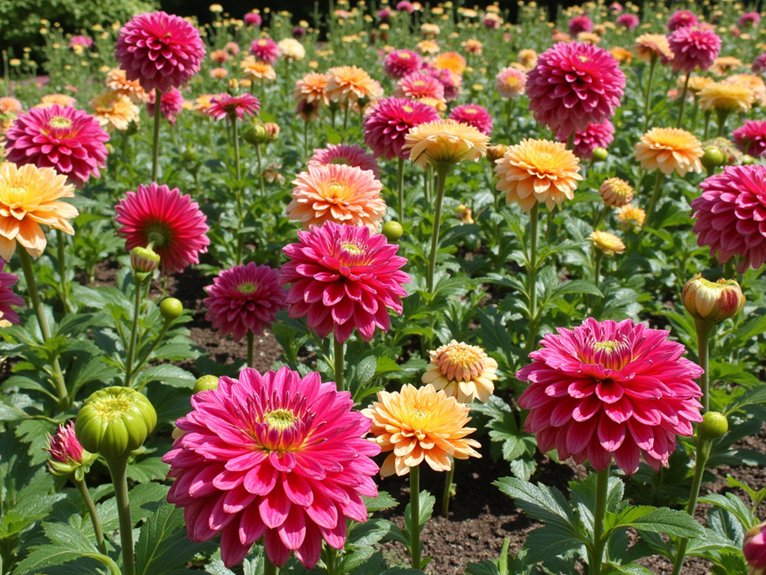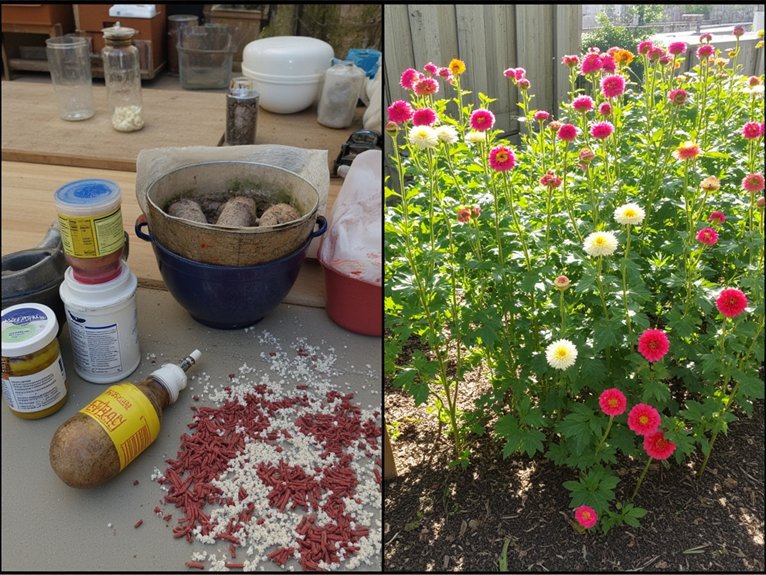When you’re planting those vibrant dahlias in your garden, you might wonder why some neighbors treat them as annuals while others swear they come back year after year. The truth is, these stunning flowers don’t fit neatly into either category. As master gardener Sarah Thompson explains, “Dahlias are tender perennials, which means their survival depends entirely on your climate zone.” Understanding this unique classification will help you make smart decisions about your dahlia care strategy.
Contents
Understanding the Unique Nature of Dahlias

While dahlias are often categorized simply as annuals or perennials, they’re actually tender perennials with unique growing requirements based on your climate zone.
Understanding dahlia varieties and their blooming cycles will help you determine how to treat these vibrant flowers in your garden. In zones 8-10, you’ll find your dahlias returning yearly, while zone 7 gardeners can protect their plants with winter mulching. If you’re gardening in zones 6 or below, you’ll need to treat your dahlias as annuals or dig up the tubers before frost.
Your dahlia’s success depends on proper temperature ranges: They thrive between 68°F and 80°F during growing season.
Climate Zones and Their Impact on Dahlia Growth
Throughout different climate zones, dahlias display varying growth patterns that directly affect how you’ll need to care for them. Their climate adaptability determines whether they’ll act as perennials or annuals in your garden.
In hardiness zones 8-10, you’ll find dahlias returning year after year without much fuss. If you’re in zone 7, you can still grow them as perennials with proper winter mulching. However, in zones 6 and below, you’ll need to treat dahlias as annuals or dig up their tubers before winter frost sets in.
The Art of Overwintering Dahlia Tubers

When temperatures begin to drop below 50°F, you’ll need to take into account overwintering your dahlia tubers to guarantee their survival. For successful tuber storage, dig up your plants after the first frost has blackened the foliage. Clean off excess soil and let them dry for 24 hours.
Store your tubers in a container filled with vermiculite or peat moss, maintaining temperatures between 32-50°F. A basement or garage often provides ideal conditions. “Winter protection is essential for preserving next season’s blooms,” notes Master Gardener Jane Smith. “Check monthly for rot or shriveling, and remove affected tubers immediately.”
Best Practices for Growing Dahlias in Any Zone
Because dahlias can thrive in any growing zone with the right care, you’ll need to adapt your growing strategy based on your local climate. “Success with dahlias comes down to understanding your zone’s requirements and following proper planting techniques,” explains horticulturist Dr. Sarah Chen.
For ideal growth:
- Plant tubers 6-8 inches deep in well-draining soil
- Space plants 9-24 inches apart based on variety
- Apply balanced fertilizer monthly during growing season
- Monitor for slugs and implement pest management early
- Water deeply but avoid overwatering
In zones 6 and below, treat as annuals or dig up tubers before frost. Zones 7-10 can leave tubers in ground with proper mulching.
Making the Choice: Annual vs. Perennial Cultivation

The decision to grow dahlias as annuals or perennials will impact your gardening strategy and maintenance routine. “Many gardeners don’t realize they have a choice in how they approach dahlia cultivation,” notes garden expert Maria Torres.
Annual benefits include simpler maintenance, no winter storage worries, and flexibility in garden design. You’ll need to purchase new tubers yearly, but you won’t face perennial drawbacks like extensive winter protection or storage requirements.
Consider your climate zone carefully – if you’re in zones 6 or below, growing as annuals makes practical sense. Zones 7-10 offer the perennial option, though you’ll need to provide winter protection through mulching or tuber storage.
